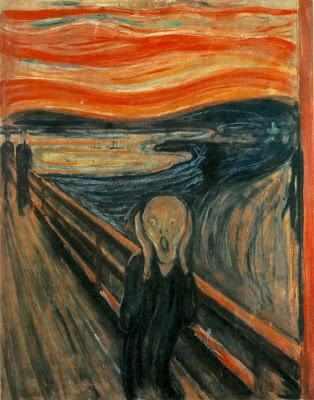 |
| The Scream by Edvard Munch (Norwegian); 1893; oil, tempura, and pastel on board. Location: Oslo, Norway; The National Gallery. |
 |
Allow me to elaborate with some background information you probably didn't know: Edvard Munch, like many now well-known artists, suffered from psychological issues, including anxiety and hallucinations. His paintings usually represent some state of mind or emotion rather than any sort of physically observed reality.
Munch observed Impressionism (which is a movement in Art History where the subjects of the paintings aren't drawn realistically but they give you the impression of the subject), Post-impressionism (which came after Impressionism and sort of exaggerated its qualities), and symbolism. In addition to using what he saw in these observations, Munch used distortion and color as his forms of expressions—both of which are easily observed in The Scream, his best-known work.
The painting gives the impression of a figure on a boardwalk, holding its head, with its mouth open—presumably screaming. The figure appears liquid because its spine is curved in an unnatural way, and it is almost skeleton in appearance because its very frail and lacks and hair on its head. In the background of the boardwalk, two more figures appear to be walking away from the main figure.
Munch has used visible brush strokes, showing directionalities in the lines made, which includes the diagonal of the boardwalk, and the curves of the sky and water—upon which you get the impression of ships. The sky is similar to a sunset in that there are various hues of red, orange, yellow, pink, and blue flowing in horizontal waves, while the water below sort of reflects those colors in the midst of blues, greys, and turquoise colors that swirl and meander.
Munch described the piece, "I was walking down the road with two friends when the sun set; suddenly, the sky turned as red as blood. I stopped and leaned against the fence, feeling unspeakably tired. Tongues of fire and blood stretched over the bluish black fjord. My friends went on walking, while I lagged behind, shivering with fear. Then I heard the enormous, infinite scream of nature." Having read what the artist had to say about the work, do you feel differently about it? What if I told you the piece set a record for the highest price ever fetched in an auction by a work of art at $120 million (it sold in May 2012)?
One version of The Scream is in the permanent collection of the National Gallery in Oslo, and another version is currently in a temporary Exhibit at the Museum of Modern Art in New York City.




